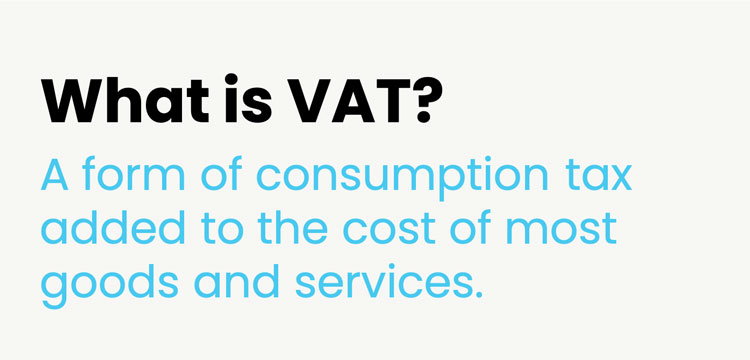Contents
IntroductionWhat is VAT?What is the VAT Flat Rate Scheme?Flat Rate VAT PercentagesVAT Flat Rate Scheme EligibilityHow to Leave the VAT Flat Rate SchemeChanges in the VAT Flat Rate Scheme
Introduction
At first glance, VAT can seem like one more aspect of your business that adds to your administrative tedium. Yet, as a small business owner, you want to run your business in the most tax efficient way possible-and VAT is a common area where business owners are losing out.
Even if you've hired a small business accountant, you need to have a good grasp of the essentials.
Below, we'll dive into an aspect of VAT that business owners often raise questions about the flat rate VAT scheme. We'll run through the basics, touch on recent regulatory changes and share our answers to frequently asked questions about the scheme.
At first glance, VAT can seem like one more aspect of your business that adds to your administrative tedium. Yet, as a small business owner, you want to run your business in the most tax efficient way possible - and VAT is a common area where business owners are losing out.
Even if you've hired an accountant, you need to have a good grasp of the essentials.
Below, we'll dive into an aspect of VAT that business owners often raise questions about the flat rate VAT scheme. We'll run through the basics, touch on recent regulatory changes and share our answers to frequently asked questions about the scheme.
What is VAT?
Most of us are familiar with, or have a basic understanding of VAT (Value Added Tax). It's a type of consumption tax added to the cost of most goods and services for both B2C and B2B markets.
What is the VAT Flat Rate Scheme?
There are various VAT schemes that business owners can register for. Among these schemes, the standard rate VAT scheme and VAT flat rate scheme are commonly used by small businesses.
Under the standard rate VAT scheme, you need to sum up the VAT you've charged to your clients, and deduct the VAT you've paid on goods and services purchased.
You'll pay the difference between the VAT you charge to your clients, and the VAT you pay on your purchases. This calls for rigorous record keeping, as you need to keep track of all transactions and the rate of VAT charged.
With the VAT flat rate scheme, the process is simplified. Rather than pay out the difference between the VAT you've charged to your clients and the VAT on your purchases, you'll pay HMRC a fixed rate of VAT.
The VAT flat rate scheme is rolled out for small businesses that don't have a large turnover, thereby saving them from the hassle of tracking VAT on purchases. To be eligible for VAT schemes such as this, businesses need to have an annual turnover of £150,000 or less (excluding VAT).
The amount of VAT payable under the VAT flat rate scheme depends on the industry you operate in.
We've included a full list of the current VAT flat rate below.
This information and more about VAT schemes (including VAT retail schemes and other schemes, as well as details on how to pay VAT, reclaim VAT, and more) is also available on the Gov.uk website.
Flat Rate VAT Percentages
- Accountancy or book-keeping services: 14.5%
- Advertising businesses: 11%
- Agricultural services: 11%
- Any other activity not listed elsewhere: 12%
- Architect, civil and structural engineer or surveyor: 14.5%
- Boarding or care of animals: 12%
- Business services not listed elsewhere: 12%
- Catering services including restaurants and takeaways before 15 July 2020: 12.5%
- Catering services including restaurants and takeaways between 15 July 2020 and 30 September 2021: 4.5%
- Catering services including restaurants and takeaways between 1st October 2020 to 31st March 2022: 8.5%
- Computer and IT consultancy or data processing: 14.5%
- Computer repair services: 10.5%
- Entertainment or journalism: 12.5%
- Estate agency or property management services: 12%
- Farming or agriculture not listed elsewhere: 6.5%
- Film, radio, television or video production: 13%
- Financial services: 13.5%
- Forestry or fishing: 10.5%
- General building or construction services: 9.5%
- Hairdressing or other beauty treatment services: 13%
- Hiring or renting goods: 9.5%
- Hotel or accommodation before 15 July 2020: 10.5%
- Hotel or accommodation from 15 July 2020 and after 30 September 2021: 0%
- Hotel or accommodation between 1 October 2021 and 31 March 2022: 5.5%
- Investigation or security: 12%
- Labour-only building or construction services: 14.5%
- Laundry or dry-cleaning services: 12%
- Lawyer or legal services: 14.5%
- Library, archive, museum or other cultural activity: 9.5%
- Management consultancy: 14%
- Manufacturing fabricated metal products: 10.5%
- Manufacturing food: 9%
- Manufacturing not listed elsewhere: 9.5%
- Manufacturing yarn, textiles or clothing: 9%
- Membership organisation: 8%
- Mining or quarrying: 10%
- Packaging: 9%
- Photography: 11%
- Post offices: 5%
- Printing: 8.5%
- Publishing: 11%
- Pubs before 15 July 2020: 6.5%
- Pubs between 15 July 2020 to 30 September 2021: 1%
- Pubs between 1 October 2021 to 31 March 2022: 4%
- Real estate activity not listed elsewhere: 14%
- Repairing personal or household goods: 10%
- Repairing vehicles: 8.5%
- Retailing food, confectionery, tobacco, newspapers or children's clothing: 4%
- Retailing pharmaceuticals, medical goods, cosmetics or toiletries: 8%
- Retailing not listed elsewhere: 7.5%
- Retailing vehicles or fuel: 6.5%
- Secretarial services: 13%
- Social work: 11%
- Sport or recreation: 8.5%
- Transport or storage, including couriers, freight, removals and taxis: 10%
- Travel agency: 10.5%
- Veterinary medicine: 11%
- Wholesaling agricultural products: 8%
- Wholesaling food: 7.5%
- Wholesaling not listed elsewhere: 8.5%
How Does VAT Flat Rate Scheme Work?
Under the VAT Flat Rate Scheme, businesses charge their customers the standard rate of VAT on their sales but pay HMRC a lower rate based on their specific industry. This simplified approach is designed to reduce the administrative burden of VAT compliance for small businesses.
VAT Flat Rate Scheme Eligibility
You can join the Flat Rate Scheme if:
- you’re a VAT-registered business
- you expect your VAT taxable turnover to be £150,000 or less (excluding VAT) in the next 12 months
Exemptions:
You cannot use the scheme if:
- you left the scheme in the last 12 months
- you committed a VAT offence such as VAT evasion in the last 12 months
- you joined (or were eligible to join) a VAT group in the last 24 months
- you registered for VAT as a business division in the last 24 months
- your business is closely associated with another business
- you’ve joined a margin or capital goods VAT scheme
How to Apply for Flat Rate Scheme
You can apply for the flat rate scheme in multiple ways:
You can join online while VAT registration or you can fill VAT600 FRS form and send it
- via Email at frsapplications.vrs@hmrc.gov.uk
- or Via post at BT VAT HM Revenue and Customs BX9 1WR
Prior to completing the VAT600 FRS form, make sure you've identified the correct flat rate percentage applicable to your business, as you require to include this information in your application.
Benefits of the VAT Flat Rate Scheme
- Businesses can calculate VAT quickly using a fixed flat rate percentage.
- Reduced paperwork and easier record-keeping as detailed VAT records are not necessary.
- Potential savings on accounting costs due to simplified calculations.
- Businesses can easily manage Cash flow
Have a look at our VAT Flat Rate Calculator to check if your business is a good fit for the scheme.
VAX Inclusive Turnover and VAT Taxable Turnover
It's important for businesses to accurately determine their VAT inclusive turnover and VAT taxable turnover to ensure they are using the correct flat rate percentage and comply with the VAT regulations in the UK.
VAT inclusive turnover refers to the total value of sales made by a business, including the VAT amount charged to customers (in other words, it represents the total amount of money received by the business, including VAT). On the other hand, VAT taxable turnover refers to the value of sales made by a business that are subject to VAT (excluding any sales that are exempt from VAT or outside the scope of VAT).
The Flat Rate Scheme allows eligible businesses to simplify their VAT calculations by applying a fixed flat rate percentage to their VAT inclusive turnover to determine their VAT liability.
How to Leave the VAT Flat Rate Scheme
You need to exit the scheme if:
- You no longer qualify for the flat rate VAT scheme.
- On the anniversary of your joining, your turnover in the past 12 months exceeded £230,000 (including VAT), or you expect it to be exceeding in the coming 12 months.
- You expect your total income in the next 30 days alone to surpass £230,000 (including VAT).
Changes in the VAT Flat Rate Scheme
HMRC introduced regulatory changes in April 2017 to combat the abuse of the scheme, and ensure that all businesses are paying the required taxes.
A new flat rate category, known as the 'limited cost trader' was introduced to remove the cash advantage for businesses with limited costs.
Limited Cost Trader VAT Flat Rate Scheme
You're classified as a 'limited cost business' if your goods cost less than either:
- 2% of your turnover
- £1,000 a year (if your costs are more than 2%)
If you meet the criteria for a 'limited cost business', you're required to pay a higher rate of 16.5%. This will likely affect many 'labour-only' businesses, but if you're still unsure about whether you fall under this category, you can work this out using the Gov.uk VAT flat rate calculator.
Frequently Asked Questions About the VAT Flat Rate
1. What are applicable goods under the limited cost trader test?
Items that aren't considered applicable goods include:
- Accountancy fees
- Advertising costs
- Costs of food and drink for you or your staff members
- Electronically downloaded services, such as a magazine subscription
- Equipment rental
- Laptop or mobile phone for use by the business
- Software that you've downloaded
- Office rental expenses
- Bespoke software
Do note that this isn't a definitive list, and we recommend checking in with our accountants at Forma on any items that you're unsure about.
2. How often do I need to apply the limited cost trader test?
The test will need to be completed each time you complete a VAT return.
That's because you can fall into and outside of the limited cost trader flat rate category, if your costs fluctuate around the 2% mark.
3. Does the 1% discount apply to limited cost businesses in their first year as a VAT-registered business?
Yes, this has been confirmed by HMRC.






















































.png)
